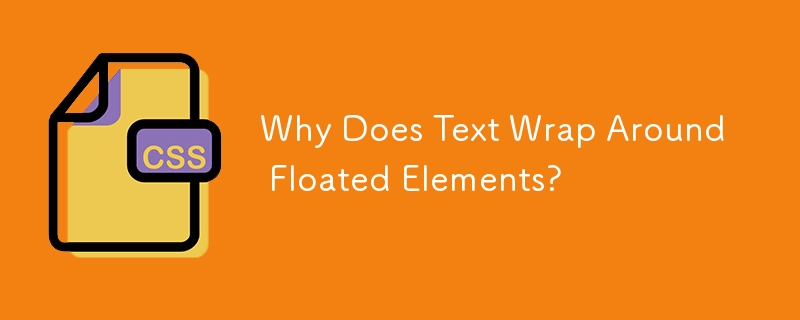Why Does Text Wrap Around Floated Elements?

Text Wrapping Anomaly: Why Does Text Flow Around Floats?
When positioning elements on a web page, the default behavior of HTML elements is to flow from top to bottom, as specified in the normal document flow. However, when the float property is applied to an element, this behavior changes.
Floating Elements: Breaking the Flow
Float places an element on the left or right side of its container, causing text and inline elements to wrap around it. This is because the floated element is removed from the normal flow of the page, meaning that other elements can overlap or be overlapped by it, similar to elements positioned absolutely.
Text and Inline Elements: The Only Exceptions
While all other elements are affected by the position of a floated element, text and inline elements are the exception. They continue to wrap around the floated element, avoiding overlap.
Understanding Float Properties
According to the CSS documentation:
- The float CSS property places an element on the left or right side of its container, allowing text and inline elements to wrap around it.
- The element is removed from the normal flow of the page, though still remaining a part of the flow.
Based on these properties, we can conclude that:
- Removed from normal flow: Floated elements can overlap or be overlapped by other elements in the normal flow.
- Wrapping exception for text and inline elements: These elements will always wrap around floated elements, regardless of their position.
Example in Action
Consider the following HTML and CSS code:
<code class="html"><div class="float"></div> <div class="blue"></div></code>
<code class="css">.float {
width: 100px;
height: 100px;
background: red;
float: left;
}
.blue {
width: 200px;
height: 200px;
background: blue;
}</code>In this example, the red div with the class "float" will be positioned on the left side, while the blue div with the class "blue" will be positioned below it. However, any text that appears between the red and blue divs will wrap around the red div, maintaining the integrity of the text flow.
The above is the detailed content of Why Does Text Wrap Around Floated Elements?. For more information, please follow other related articles on the PHP Chinese website!

Hot AI Tools

Undresser.AI Undress
AI-powered app for creating realistic nude photos

AI Clothes Remover
Online AI tool for removing clothes from photos.

Undress AI Tool
Undress images for free

Clothoff.io
AI clothes remover

Video Face Swap
Swap faces in any video effortlessly with our completely free AI face swap tool!

Hot Article

Hot Tools

Notepad++7.3.1
Easy-to-use and free code editor

SublimeText3 Chinese version
Chinese version, very easy to use

Zend Studio 13.0.1
Powerful PHP integrated development environment

Dreamweaver CS6
Visual web development tools

SublimeText3 Mac version
God-level code editing software (SublimeText3)

Hot Topics
 Vue 3
Apr 02, 2025 pm 06:32 PM
Vue 3
Apr 02, 2025 pm 06:32 PM
It's out! Congrats to the Vue team for getting it done, I know it was a massive effort and a long time coming. All new docs, as well.
 Building an Ethereum app using Redwood.js and Fauna
Mar 28, 2025 am 09:18 AM
Building an Ethereum app using Redwood.js and Fauna
Mar 28, 2025 am 09:18 AM
With the recent climb of Bitcoin’s price over 20k $USD, and to it recently breaking 30k, I thought it’s worth taking a deep dive back into creating Ethereum
 Can you get valid CSS property values from the browser?
Apr 02, 2025 pm 06:17 PM
Can you get valid CSS property values from the browser?
Apr 02, 2025 pm 06:17 PM
I had someone write in with this very legit question. Lea just blogged about how you can get valid CSS properties themselves from the browser. That's like this.
 Stacked Cards with Sticky Positioning and a Dash of Sass
Apr 03, 2025 am 10:30 AM
Stacked Cards with Sticky Positioning and a Dash of Sass
Apr 03, 2025 am 10:30 AM
The other day, I spotted this particularly lovely bit from Corey Ginnivan’s website where a collection of cards stack on top of one another as you scroll.
 A bit on ci/cd
Apr 02, 2025 pm 06:21 PM
A bit on ci/cd
Apr 02, 2025 pm 06:21 PM
I'd say "website" fits better than "mobile app" but I like this framing from Max Lynch:
 Using Markdown and Localization in the WordPress Block Editor
Apr 02, 2025 am 04:27 AM
Using Markdown and Localization in the WordPress Block Editor
Apr 02, 2025 am 04:27 AM
If we need to show documentation to the user directly in the WordPress editor, what is the best way to do it?
 Comparing Browsers for Responsive Design
Apr 02, 2025 pm 06:25 PM
Comparing Browsers for Responsive Design
Apr 02, 2025 pm 06:25 PM
There are a number of these desktop apps where the goal is showing your site at different dimensions all at the same time. So you can, for example, be writing
 Why are the purple slashed areas in the Flex layout mistakenly considered 'overflow space'?
Apr 05, 2025 pm 05:51 PM
Why are the purple slashed areas in the Flex layout mistakenly considered 'overflow space'?
Apr 05, 2025 pm 05:51 PM
Questions about purple slash areas in Flex layouts When using Flex layouts, you may encounter some confusing phenomena, such as in the developer tools (d...






